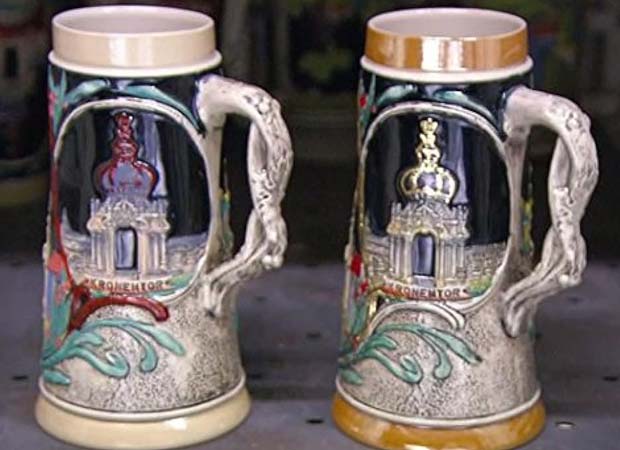Did you know Japan has a thriving scene for “Beer Steins Made in Japan”? While often associated with Germany, these hefty mugs also hold a special place in Japan’s brewing culture.
But what makes them unique? Dive in with us as we explore the fascinating world of Japanese beer steins, from traditional techniques to modern twists!
Read More: Best Hotel in Hiroshima Japan
Whether you’re a beer enthusiast, a collector of unique mugs, or simply curious about Japanese craftsmanship, this post is for you.
While Germany might be the first place that pops into your head when you think “beer steins,” Japan holds a surprising and delightful secret in the world of these hefty mugs. Forget the chunky ceramic stereotypes; Japanese beer steins offer a unique blend of tradition, artistic flair, and modern innovation that will leave you thirsty for more!
How do I know if my beer stein is valuable?
We offer guidance specific to “Beer Steins Made in Japan” in this instance. While Japanese steins possess unique characteristics, the process of determining their value aligns with general principles applicable to all steins.
However, I can provide you with a detailed, easy-to-understand guide on assessing the value of your Beer Steins Made in Japan:
Have you inherited a hefty mug or stumbled upon a charming stein at a flea market? You might be curious about its worth. Fear not, for here’s a roadmap to navigate the exciting, sometimes confusing, world of Beer Steins Made in Japanvaluation!
Step 1: Material Matters
First, identify the material. Popular choices include ceramic, glass, pewter, and wood—generally, older materials like hand-painted porcelain or intricately carved wood fetch higher prices. Additionally, rarer materials like ivory or silver can be precious.
Step 2: Age is Just a Number (With Asterisks)
Older sometimes equals expensive. Steins from the 18th and 19th centuries often hold more value, but condition and rarity play crucial roles. A well-preserved, 50-year-old stein might be more valuable than a chipped antique.
Step 3: Decode the Markings
Look for manufacturers’ marks, logos, or inscriptions on the base or underside. Research these markings online or consult expert resources to identify the maker, origin, and potential period. Famous manufacturers or limited editions can significantly increase value.
Step 4: The Art of Decoration
The design matters! Intricate hand-painted scenes, historical motifs, or cultural symbols can be highly sought-after. Look for details like raised paint, unique colour palettes, or specific themes that might hold historical or cultural significance.
Step 5: Condition is King (or Queen)
Chips, cracks, repairs, or fading significantly impact value. A pristine stein in top condition commands a premium compared to a damaged one, regardless of age or origin.
Step 6: Seek Expert Guidance
Consider consulting a professional appraiser specializing in antiques or collectibles for a definitive assessment. They possess the knowledge and experience to accurately evaluate your stein based on all the above factors and current market trends.

What is a good beer stein holding time?
Forget lederhosen contests, let’s talk Beer Steins Made in Japan holding! While gripping a full stein for as long as possible might seem like pure strength, it’s a delicate balance of technique, training, and, yes, a bit of arm muscle. So, what’s a good time to aim for?
The Untrained Reality:
For the average person without prior training, holding a Japanese stein (typically lighter than their German counterparts) for 3-5 minutes is a respectable feat. Ladies might find their comfort zone around 1-3 minutes. Remember, these steins still weigh around 2 pounds full, so it’s not a walk in the park!
Pushing the Limits:
With dedicated training, your stein-holding prowess can skyrocket. Regular exercises targeting shoulders, forearms, and core can significantly improve your endurance. Actual stakeholders in Japan and internationally have reached astonishing times exceeding 20 minutes! But remember, safety and proper form are paramount.
Beyond Minutes and Bragging Rights:
While aiming for a long time is fun, keep sight of the experience! Japanese stein holding emphasizes enjoying the beer, celebrating camaraderie, and appreciating the craftsmanship of the stein itself. So, focus on proper form, savour the brew, and let the good times flow, even if you don’t break any records.
Remember:
- It’s a personal challenge, not a competition. Pace yourself and listen to your body.
- Respect the tradition: Practice good posture and avoid compromising form for longer holds.
- Celebrate the journey: Enjoy the beer, the company, and the unique Japanese stein culture.
Special for Beer Steins Made in Japan
A Fusion of East and West: Imagine sleek, classic stein shapes adorned with delicate cherry blossoms, majestic Mount Fuji, or playful koi fish. Japanese artisans masterfully blend European influences with local motifs, creating stunning pieces celebrating their heritage.
Beyond Porcelain: While ceramic reigns supreme, prepare to be surprised by the diversity! You might find wooden steins exuding warmth, gleaming pewter mugs boasting intricate details, or even lacquerware steins showcasing artistic mastery. Each material brings its own charm to the table.
More Than Just Souvenirs: Be aware of their tourist appeal. Beer Steins Made in Japan are deeply cherished by locals for both their practicality and beauty. They’re often used for special occasions, adding a touch of elegance and cultural pride to any gathering.
A Collector’s Paradise:
If you’re an enthusiast, get ready to unleash your inner treasure hunter! With diverse designs, limited editions, and regional variations, Japanese steins offer a kaleidoscope of collecting possibilities. Whether you seek traditional folk art, modern interpretations, or specific regional styles, there’s a stein out there waiting to be your prized possession.
Ready to Embark on Your Stein Journey? Buckle up! We’ll guide you through:
- The different types of Beer Steins Made in Japan: from classic tankards to unique regional shapes.
- Unveiling special features: learn to identify traditional motifs, materials, and craftsmanship hallmarks.
- Finding your perfect stein: discover online resources, hidden gems in Japan, and tips for making informed purchases.
Conclusion for Beer Steins Made in Japan
So, ditch the preconceived notions and raise a glass to a whole new world of beer steins! Join us on this exciting exploration of Beer Steins Made in Japan, where every sip is an adventure into culture, artistry, and a unique piece of Japanese heritage.

1 thought on “How Beer Steins Made in Japan?”
Comments are closed.